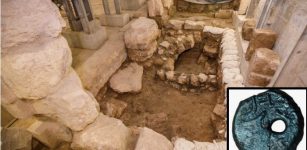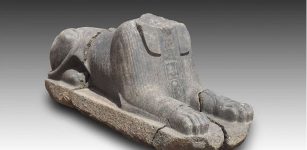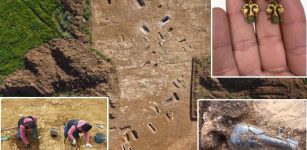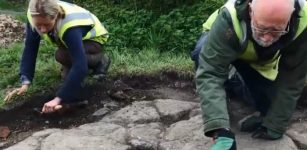Conwy Castle In Snowdonia: Outstanding Medieval Fortification In Europe
A. Sutherland - AncientPages.com - Conwy Castle in Snowdonia is considered one of Europe's most impressive military structures of the late 13th century and early 14th century that survived until today.
Image credit: Adobe Stock - Lukasz Pajor
Kings and feudal lords ruled over their lands from the Middle Ages' grand and massive power centers.
Conway Castle is undoubtedly one of Britain's most impressive and majestic medieval fortresses. It is an impressive fortress and a fortified town, the massive accompanying walls forming an integral portion of the defense.
The town walls "are over a mile in length and are in a singularly good state of preservation; there are twenty-one towers, arranged at regular intervals along this enceinte, and four gates, over one of which is a row of machicoulis, twelve in number, projecting from the upper part of the wall. It was also protected by a dry ditch and with drawbridges placed before the gateways..." 1
The Outer Ward, with the great hall and chapel. Image credit: Albertran - CC BY 3.0
Conwy Castle was built for Edward I, King of England (1272 – 1307), by the master military architect of his age, James of St. George d'Esperanche (c.1230 – 1309). Master James was an architect from Savoy responsible for designing many of Edward I's castles, including Conwy.
The total cost of the new four castles in Wales was more than ten times Edward I's annual revenue, but it was necessary; a revolt could break out at any time.
The site for the construction of the Conwy Castle was perfectly chosen. The structure was a masterpiece of design. Conwy Castle was previously occupied by Aberconwy Abbey, located on a hill looking over the critical crossing over the River Conwy.
This famous medieval fortress is exceptionally well preserved. It contains the most intact set of medieval royal apartments in Wales. The high curtain wall and eight lofty towers built over 700 years ago are still impressive.
Reconstruction of Conwy Castle and town walls at the end of the 13th century. Model located in Conwy Castle. Image credit: Hchc2009 - CC BY-SA 3.0
Based on ancient sources, Conwy Castle and the associated walled settlement – a garrison town - were built within five years under the leadership of Master James and 1,500 craftsmen working at the construction site.
Two barbicans (fortified gateways), eight massive and 21-meter high towers, and a great bow-shaped hall all sit within its distinctive elongated shape due in part to the narrow rocky outcrop on which the castle stands.
No concentric walls within walls were needed in this mighty military fortress.
The strength and inaccessibility of Conwy Castle come from the massive rock on which it stands. The castle has a postern gate leading down to the river, allowing resupplying from the sea.
The rectangular castle is built from local and imported stone material and occupies a coastal ridge, initially overlooking a crossing point over the River Conwy.
'
Conwy Castle is seen from the west, showing the barbican guarding the Outer Ward. Image credit: David Dixon - CC BY-SA 2.0
The outer wall remains with a great hall, chambers, kitchen, an Inner and Outer Ward, private, well-lit, heated rooms, and a royal chapel. The inner ward was a private area for King Edward and his queen, Eleanor of Castile, and the family.
There were only two approaches to the castle; the most important was the main entrance in the form of a high stone ramp, running up towards a swinging or pivoting "drawbridge"; the ditch was 28 feet deep from the drawbridge to the bottom.
Over the next few centuries, the castle played an important part in several wars. In 1665, the castle was ruined entirely; in the late 18th and early 19th centuries, it became an attractive destination for artists, and today, it's a tourist attraction.
Written by – A. Sutherland AncientPages.com Staff Writer
Updated on January 29, 2024
Copyright © AncientPages.com All rights reserved. This material may not be published, broadcast, rewritten or redistributed in whole or part without the express written permission of AncientPages.com
Expand for referencesReferences:
- Ashdown, Charles H., British Castles
K. Ralls-MacLeod,I. Robertson,The Quest for the Celtic Key
More From Ancient Pages
-
 Secret Coded Boontling Language Of Northern California
Ancient History Facts | Apr 8, 2019
Secret Coded Boontling Language Of Northern California
Ancient History Facts | Apr 8, 2019 -
 Artifacts Discovered In Ancient Florida Sinkhole Can Re-Write History Of North America
Archaeology | May 14, 2016
Artifacts Discovered In Ancient Florida Sinkhole Can Re-Write History Of North America
Archaeology | May 14, 2016 -
 26,000-Year-Old Footprints In Chauvet Cave: Oldest Evidence Of Human-Canine Relationship
Featured Stories | Dec 29, 2016
26,000-Year-Old Footprints In Chauvet Cave: Oldest Evidence Of Human-Canine Relationship
Featured Stories | Dec 29, 2016 -
 Polynesian Stonehenge: Enigmatic Ha’amonga ‘a Maui Trilithon Of Tonga
Civilizations | Sep 11, 2018
Polynesian Stonehenge: Enigmatic Ha’amonga ‘a Maui Trilithon Of Tonga
Civilizations | Sep 11, 2018 -
 Alexander The Great And The Prophecy Of The Tree Of The Sun And Moon
Featured Stories | Jun 10, 2019
Alexander The Great And The Prophecy Of The Tree Of The Sun And Moon
Featured Stories | Jun 10, 2019 -
 Ancient Doll And Mythical Animal – 4,500-Year-Old Toys Discovered In Siberia
Archaeology | Dec 30, 2017
Ancient Doll And Mythical Animal – 4,500-Year-Old Toys Discovered In Siberia
Archaeology | Dec 30, 2017 -
 The Colored Skeletons Of 9000-Year-Old Çatalhöyük (Catalhoyuk), Turkey – New Examination
Archaeology | Mar 18, 2022
The Colored Skeletons Of 9000-Year-Old Çatalhöyük (Catalhoyuk), Turkey – New Examination
Archaeology | Mar 18, 2022 -
 Rare Bronze Hand Found At Roman Vindolanda
Archaeology | Jul 11, 2023
Rare Bronze Hand Found At Roman Vindolanda
Archaeology | Jul 11, 2023 -
 Unexpected Archaeological Discovery May Re-Write English Civil War History
Archaeology | Feb 3, 2023
Unexpected Archaeological Discovery May Re-Write English Civil War History
Archaeology | Feb 3, 2023 -
 New Evidence Of The Destruction Of The Second Temple In The City Of David
Archaeology | Aug 5, 2023
New Evidence Of The Destruction Of The Second Temple In The City Of David
Archaeology | Aug 5, 2023 -
 Mysterious Sherbrooke Stones – Did Africans Visit North America 2,500 Years Ago?
Artifacts | Nov 23, 2017
Mysterious Sherbrooke Stones – Did Africans Visit North America 2,500 Years Ago?
Artifacts | Nov 23, 2017 -
 Cartography Shows That The Isthmus Of Tehuantepec Was Used As An Inter-Oceanic Passage In The 16th Century
Archaeology | Oct 21, 2022
Cartography Shows That The Isthmus Of Tehuantepec Was Used As An Inter-Oceanic Passage In The 16th Century
Archaeology | Oct 21, 2022 -
 Mini Sphinxes, Huge Baboon Statue And Blocks From Khufu’s Reign Discovered In Heliopolis
Archaeology | Jun 20, 2022
Mini Sphinxes, Huge Baboon Statue And Blocks From Khufu’s Reign Discovered In Heliopolis
Archaeology | Jun 20, 2022 -
 Hayk – Legendary Patriarch And Founder Of Armenia Who Defeated King Bel Of Babylon
Featured Stories | Feb 10, 2022
Hayk – Legendary Patriarch And Founder Of Armenia Who Defeated King Bel Of Babylon
Featured Stories | Feb 10, 2022 -
 Mongol Empire: Rise And Fall Of One The World’s Largest And Fearsome Empires
Featured Stories | Mar 26, 2021
Mongol Empire: Rise And Fall Of One The World’s Largest And Fearsome Empires
Featured Stories | Mar 26, 2021 -
 Justinianic Plague Struck England Before It Reached Constantinople And It Did Not Wipe Out The Roman Empire
Archaeology | Nov 19, 2021
Justinianic Plague Struck England Before It Reached Constantinople And It Did Not Wipe Out The Roman Empire
Archaeology | Nov 19, 2021 -
 Incredible Roman Necropolis With Dressed Skeletons Buried In Ornate Tombs Discovered Close To The Ancient City Of Tarquinia
Archaeology | Jan 9, 2024
Incredible Roman Necropolis With Dressed Skeletons Buried In Ornate Tombs Discovered Close To The Ancient City Of Tarquinia
Archaeology | Jan 9, 2024 -
 Uncovering 16th Century Scottish Royal Dockyards Used By King James IV’s Navy
Archaeology | May 24, 2018
Uncovering 16th Century Scottish Royal Dockyards Used By King James IV’s Navy
Archaeology | May 24, 2018 -
 There Is Evidence Humans Reached North America 130,000 Years Ago – Archaeologist Says
Archaeology | Mar 28, 2022
There Is Evidence Humans Reached North America 130,000 Years Ago – Archaeologist Says
Archaeology | Mar 28, 2022 -
 Biblical Mystery Of Urim And Thummim: God’s Puzzling Communication Devices
Ancient Mysteries | Jun 18, 2017
Biblical Mystery Of Urim And Thummim: God’s Puzzling Communication Devices
Ancient Mysteries | Jun 18, 2017




